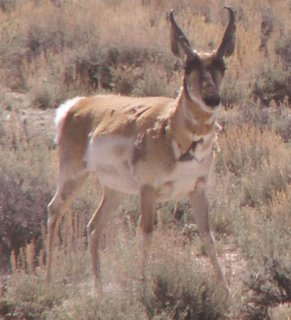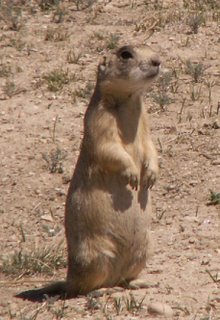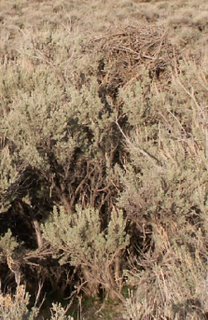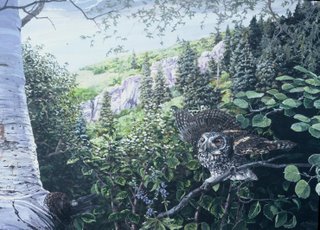
To the casual traveler driving across Wyoming, the biological richness of the Sagebrush Steppe is mostly hidden. The most obvious denizens are Pronghorn (
Antilocapra americana), relicts from the Pliocene with no living relatives, although an additional twelve extinct genera have been identified within their family.

Famous for speed, they are capable of reaching 55 mph (88kph) in a sprint, with a normal cruising speed around 30 mph (48 kph). On the American Pleistocene plains, such velocity allowed them to outrun giant
Miracinonyx cheetahs into the modern age. My friend Scott Carrier established himself as a writer by describing his
efforts to run down a Pronghorn. Buy his book and see if he succeeded.
Having lived in large herds during the winter, the bucks begin to establish their own territories in April. Successful males will inseminate all the does in their harem in late summer, and spend much of the intervening six months fighting off challengers, often suffering multiple horn wounds like the one seen here. Right about now (early June) the kids that were conceived last year are being born. Two springs ago, I discovered a single newborn Pronghorn kid (twins are the norm, although first pregnancies usually result in single kids) in the west Utah desert. It cowered in the grasses, ostensibly lacking the strength to flee, while the entire extended family stood several yards away, staring me down. By the time the kid reaches four days of age it can outrun a human.

Other artiodactyls on the Anticline include Moose (
Alces alces), Elk (
Cervus elaphus), Mule Deer (
Odocoileus hemionus), and, I am told, White-tailed Deer (
O. virginianus). Barbed wire fences, a deadly threat to large flying birds, form barriers to Pronghorn, which are unable to jump, and hurdling deer often get tangled in them. This photo shows a fence that Steve and I treated with beer cans last year, to make it more obvious to grouse. This Mule Deer died just a few feet from where we ran out of cans--statistically insignificant, but it suggests that the cans may discourage deer from jumping a fence. Despite the dangers these fences represent, many of them serve to keep sheep and cattle out of riparian areas, and ensure that livestock grazing on the Anticline maintains a low impact.

The astonishing population of large raptors here is largely attributable to this little guy, Richardson's Ground Squirrel (
Spermophilus richardsonii). This rodent occurs in huge numbers on the Anticline, and though it is less social than many
Spermophilus species, in favorable habitat it often dwells in vast colonies. It feeds on the leaves and seeds of sage brush, grasses, and other plants, and includes many insects in its diet. Nesting Ferruginous Hawks feed primarily on this creature, and it's also an important component in the diets of other buteos, Prairie Falcons, and probably Golden Eagles.

The largest member of the huge Anticline rodent community is the White-tailed Prairie Dog (
Cynomys leucurus). Very similar to its better-known black-tailed cousin (
C. ludovicianus), it does not develop the conspicuous prairie dog "towns" of that species. The raptor population is sustained by other rodents as well, including chipmunks (
Tamias spp.), voles (
Microtus spp.) and deer mice (
Peromyscus spp.).

One can't walk far through the sagebrush without bumping a Nuttall's Cottontail (
Sylvilagus nuttalli), another item at the finest hawk diner in the West. White-tailed Jackrabbits (
Lepus townsendii) are also abundant, but are too powerful for any raptors to feed on regularly, except Golden Eagles, the most determined Ferruginous Hawks, and maybe an occasional Great Horned Owl that's even more psychopathic than normal. Jackrabbits are actually hares, not rabbits. One major difference between the two is that young hares are precocial, and can move about soon after birth. I've been told that Pygmy Rabbits (
Sylvilagus idahoensis) also occur on the Anticline, but I've never seen one. Lest I lead you to think that rabbits are of little interest beyond hawk chow, have a look at
this post by Darren Naish.
The Anticline's most conspicuous mammalian predators are the Badger (
Taxidea taxus) and the Coyote (
Canis latrans), both of which are abundant. Long-tailed Weasels (
Mustela frenata) and Striped Skunks (
Mephitis mephitis) may also be encountered. On my most recent trip I saw a pied shrew that looked like a
Sorex species. I've seen no evidence of cats, though they might occur. Reintroduced Wolves (
Canis lupus) are beginning to show up in the area. A few years ago, a local rancher, Billy Mayo, lost a sheep to a canid. Fish & Wildlife officials inspected the kill, and said the culprit was a domestic dog. After losing his third sheep within a week, Billy mounted his snowmobile and followed the tracks, eventually catching up with a wolf, which he lassoed, and dragged back to his ranch, locking it in a trailer: an amazing feat. He called the Fish & Wildlife officials and told them to come get their "dog."
The Anticline fauna is reptile-poor. I've only encountered Short Horned Lizards (
Phrynosoma douglasii).

Let's finish up where we started: back with the birds. The large and common Raven (
Corvus corax) is the easiest bird to observe on the anticline. It's credited with being the chief predator of Sage Grouse eggs, despite a lack of data on the subject. Likewise, conventional wisdom among Wyoming locals states that Ravens haitually peck out calves' eyes, but I've yet to meet an actual witness to such an event. Ravens certainly are resourceful birds with a combination of brains and versatility, and either act is within their skill set. Upstairs from this hen raven and two fledglings is a Cliff Swallow (
Petrochelidon pyrrhonota) nest. Both these and Tree Swallows (
Tachycineta bicolor) are common along the rivers.

The region's other common corvid is the Black-billed Magpie (
Pica hudsonica). The kind of low trees these birds prefer to nest in are rare here, but along draws, the sagebrush can grow tall enough to provide a perfect site for their spherical mud-and-stick nests.

This nest contained five chicks, maybe three days old.
A number of perching bird species inhabit the Anticline; most of them stick close in the brush and are difficult to observe. These include several sparrows, including the Sage Sparrow (
Amphispiza belli), Brewer's Sparrow (
Spizella breweri), Vesper Sparrow (
Pooectes gramineus) and Lark Sparrow (Chondestes
grammacus).

The least bashful perching bird is the Horned Lark (
Eremophila alpestris), whose boldness is probably born of confidence; it is among the most athletic fliers I know. As a teenager I participated in an automobile accident that involved trying to keep up with a small group of them. Feeding on a wide range of plant and arthropod foods, they range through much of the northern hemisphere.

Horned Larks build a grass nest on the ground, underneath a sagebrush. Three to five spotted eggs are laid early in April. Both parents provision the chicks, mostly with insects. At about three weeks of age, the young larks begin to run about the vicinity of the nest. Their cryptic coloration provides some protection, but their inability to fly makes these few days the most perilous of their lives.

The Sage Thrasher (
Oreoscoptes montanus) is a shy and inconspicuous denizen of the sage steppes. A bit smaller than an American Robin (
Turdus migratorius), it is a distant cousin of that bird. It lays its beautiful eggs in a well-built nest, deep within the confines of a thick sagebrush. The incubating female invariable slips away unseen as the nest is approached.

These dry steppes are bisected by a few rivers. The riparian systems along these waterways provide a stark contrast from the surrounding country. Among the most commonly seen perching riparian birds is the Western Kingbird (
Tyrannus verticalis), which seeks a prominent perch from which to hawk the flying insects upon which it lives.

Many species of waterfowl live along these rivers, including the Trumpeter Swan (
Cygnus buccinator). One hundred years ago, this huge bird was nearly extinct, but thanks to intensive management, some 15,000 individuals live today, most of them in Alaska. A number of pairs nest in this region.
I've devoted three posts to discussing the animals of the Pinedale Anticline, but of course, the most important organism of this system is the Big Sagebrush (
Artemisia tridentata). A member of the genus that gave us Wormwood (
A. absynthium), and the legendary liquor absinthe, Big Sagebrush also contains complex aromatic oils that prevent most animals from feeding on it. After millions of years, a number of animals have adapted not only to feed on it, but to depend on it. It is quite possible that the camels and ground sloths that once roamed these plains were as addicted to sagebrush as their contemporary the Pronghorn. Two centuries ago, this plant dominated much of the western United States, but today just a fraction of healthy sagebrush community remains--the Pinedale Anticline represents the most vibrant remnant of sagebrush steppe.

So let's say goodbye to the Pinedale Anticline for now, but hopefully not for good. The Cretaceous formation that supports these sage steppes represents the best hope the lower 48 has of substantial new petroleum extraction, and the entire region is currently under lease for gas and oil exploration. Our thirst for gasoline, the fluid that enables me to visit the place, suggests that one day the Pinedale Anticline will no longer be a domicile of jousting Pronghorns, lekking Sage Grouse and soaring Ferruginous Hawks, but of drilling rigs and howling compressors. The choice is ours.
_____________________
All photographs in this post were taken by CPBvK on the Pinedale Anticline, May 15-17, 2006
 It's the end of the month, and the tenth edition of Circus of the Spineless, the invertebrate blog carnival, is up at Science & Sensibility. This month's Kiwi edition is the first to be hosted from outside North America. Have a look; you're bound to learn a thing or two before clicking onto the first post.
It's the end of the month, and the tenth edition of Circus of the Spineless, the invertebrate blog carnival, is up at Science & Sensibility. This month's Kiwi edition is the first to be hosted from outside North America. Have a look; you're bound to learn a thing or two before clicking onto the first post.












































